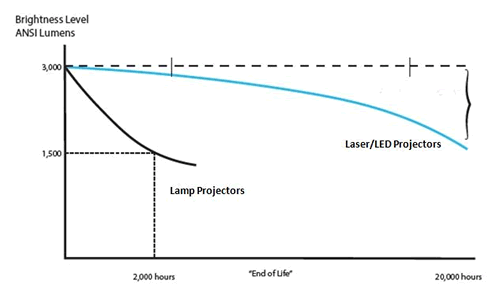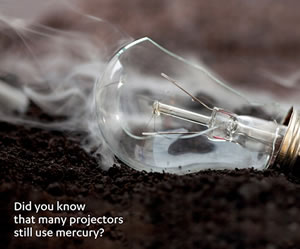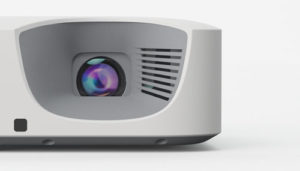With the introduction of lamp-free projectors that use Lasers & LEDs as a light source instead of lamps, you can now get projectors that provide the same high brightness and vibrant colors without the need to ever change a lamp. The new Laser & LED light sources degrade at a much slower rate than lamps and so maintain their brightness for a much longer time. Most Laser projectors are rated as having a lengthy operation life-time of up to 20,000 hours. This means that in a typical university environment, your lamp-free projector should last over 12 years, based on an average of seven hours of use a day, and 220 school days a year, that’s without ever having to change a lamp!
 What does this mean for you? It means that a 4000 lumen lamp-free projector is going to stay near 4000 lumens for the majority of its long 20,000 hour life, unlike traditional lamp projectors, where the lamps start to degrade immediately and can lose up to 50% brightness between 2,000 and 3,000 hours of use. If you do the math, that 5000 lumen lamp projector will be projecting a brightness of only 2500 lumens after a only a couple of years of use while the new laser projectors are keeping your images bright and clear for well over 10 years. 4000 lumens lamp-free projectors can provide the reliable high brightness needed for higher education’s large classrooms and most lecture halls for years and years with minimal maintenance.
What does this mean for you? It means that a 4000 lumen lamp-free projector is going to stay near 4000 lumens for the majority of its long 20,000 hour life, unlike traditional lamp projectors, where the lamps start to degrade immediately and can lose up to 50% brightness between 2,000 and 3,000 hours of use. If you do the math, that 5000 lumen lamp projector will be projecting a brightness of only 2500 lumens after a only a couple of years of use while the new laser projectors are keeping your images bright and clear for well over 10 years. 4000 lumens lamp-free projectors can provide the reliable high brightness needed for higher education’s large classrooms and most lecture halls for years and years with minimal maintenance.
And it gets better as there are numerous benefits gained from using Laser light source projection technology.
First and foremost, there are no lamps. In talks with teachers and professors, almost 80% of the complaints about projectors are about the lamps. Since lamp replacement is the single largest maintenance cost of traditional lamp projectors with replacement lamps costing hundreds of dollars over the life of the projector, lamp-free projectors will save a lot of money and aggravation because there is no need to ever purchase, stock, or replace a projector lamp ever again.
Some lamp-free projectors are now also filter-free by incorporating dust resistant cabinet designs. Their dust resistant cabinets have separate blocks, with the primary light source unit blocked off and tightly shielded. This suppresses dust intrusion and improves dust resistance, ensuring worry-free performance even in dusty environments. It also helps to maintain brightness during the long life of the projector since dust is not reaching the optical system. By eliminating dust intrusion there is no need for filters, therefore no need for cleaning, stocking, or replacing filters at your facilities
One of the more overlooked benefits is the reduced power consumption. Electricity usage could be the biggest area of savings for larger schools that use projectors in every classroom. Lamp projectors consume a high amount of electricity and generate a lot of heat. Lamp-free projectors run cool and are much more efficient to operate. Many lamp-free projectors use up to 30% less electricity right out of the box and can save up to 50% in economy mode. Also some models have an intelligent light control feature with a built-in light sensor that can detect the ambient light in your room and automatically adjust the projector to the optimum brightness level so you only use full brightness and full power when you need it.
 If sustainability and going Green are important to you then these projectors will be a big help with your earth-friendly initiatives. With the electrical savings we already mentioned there can be a significant reduction in your carbon dioxide footprint and then there is the removal of Mercury. Many people forget that lamp projectors still use Mercury vapor lamps. Mercury is a highly toxic element that is hazardous to human health and to the environment. Although the use of mercury is widely prohibited worldwide today, this hazardous substance continues to be employed as a light source for conventional projector lamps. By choosing a lamp-free projector you are contributing to a mercury-free environment and eliminating a toxic substance from your facility.
If sustainability and going Green are important to you then these projectors will be a big help with your earth-friendly initiatives. With the electrical savings we already mentioned there can be a significant reduction in your carbon dioxide footprint and then there is the removal of Mercury. Many people forget that lamp projectors still use Mercury vapor lamps. Mercury is a highly toxic element that is hazardous to human health and to the environment. Although the use of mercury is widely prohibited worldwide today, this hazardous substance continues to be employed as a light source for conventional projector lamps. By choosing a lamp-free projector you are contributing to a mercury-free environment and eliminating a toxic substance from your facility.
So why are lamp projectors still on the market? Price. Sometimes it all comes down to budgets and a lamp projector’s purchase price is still cheaper than a lamp-free projector’s. But that can be a big budgeting mistake and wind up costing you much more in the long run. Even though the initial purchase price of a lamp projector is lower, when purchasing projectors you cannot only look at the initial purchase price but need to look at the total cost of ownership.
The total cost of ownership includes all the costs that you will actually pay over the life of your projector. Total cost of ownership not only includes the purchase cost, but also the cost of using your projector, such as energy, repair and maintenance costs. Lamp-free projectors consume less energy; they can typically use up to 30% less electricity when compared to conventional lamp projectors. Lamp-free projectors have no expensive replacement lamps or filters to replace, and since they require minimal maintenance, they require minimal labor costs to maintain. When you add up the original purchase price, the cost of replacement lamps, replacement filters, labor costs, and higher energy usage, lamp-free projectors cost much less over their long 20,000 hour life.
For higher education, projectors and screens are still the most affordable technology to use to get the large screens (100” and higher) needed for students to be able to read small text and numbers. Think about replacing old costly lamp projectors with new 4000 lumen Laser & LED projectors as a great way to provide the high quality large images that the larger classrooms need and reduce maintenance costs at the same time. So if you are interested in having no more lamps to replace, no more filters to replace, less down time, lower electricity bills, and lower maintenance costs it’s time to switch to lamp-free projectors.

